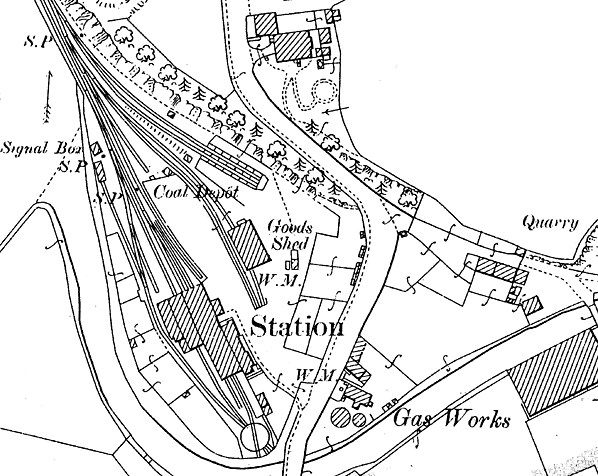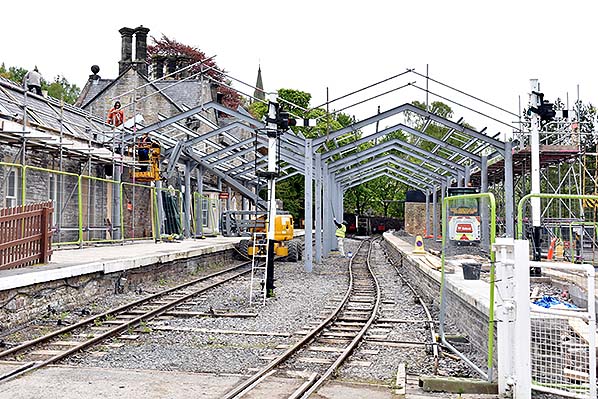
Station Name: ALSTON
|
| Date opened: | 21.5.1852 |
| Location: | On the west side of Station Road |
| Company on opening: | North Eastern Railway |
| Date closed to passengers: | 3.5.1976 |
| Date closed completely: | 3.5.1976 |
| Company on closing: | British Rail (Eastern Region) |
| Present state: | The station (Grade II listed) is now the headquarters of the South Tynedale Railway. (Narrow gauge) The station building and platform have been preserved in excellent condition. The goods shed (Grade II listed) now house 'The Hub' museum. Part of the goods dock has been preserved. A siding from the goods yard ran through a tunnel under Hexham Road to serve a stone yard and gas works. The tunnel has been converted into a workshop with access from the goods yard although it is now out of use. On the far side of Hexham Road only the tunnel parapet is visible. |
| County: | Cumberland |
| OS Grid Ref: | NY717467 |
| Date of visit: | March 1968, January 1973, April 1976, April 1978, May 1988 & June 2010. |
Notes: Alston station was 13 miles 12ch from Haltwhistle. The layout comprised a single 106yd passenger platform east of the running line, a carriage siding to the west, and several sidings either side of the platform. Unusually the southern end of the platform had steps, rather than a ramp. At the terminus a turntable was provided, but was disused by 1951.The station building (Grade II listed) is an imposing Tudoresque structure of the East Coast main line type, with random stone courses instead of the more urbane ashlar, mullioned windows, moulded door and window hoods, ball finials, and lofty coupled chimney stacks. Unfortunately its appearance was marred by the rendering of three sides. In 1904-5 a single-storey extension was added.
Although removal of the trainshed and sidings left the station somewhat bleak, it retained some delightful fixtures at closure: the LNER nameboard, gas lamps, and an original North Eastern Railway enamel Way Out sign. After closure the site, stripped of its tracks, was forlorn, but restoration of the building and the introduction of narrow-gauge trains have revitalised Alston station. It is a delightful place to visit!
The gradient was almost continually uphill from Haltwhistle, including 1 in 70 for 1½ miles between Plenmeller and Featherstone Park; and 1 in 56, the steepest stretch, for a mile near Barhaugh, between Slaggyford and Alston. A mile-long cutting was needed between Haltwhistle and Featherstone Park. Construction began in 1850 from both ends. In March 1851 Haltwhistle-Shaft Hill (Coanwood) opened for goods, and passengers in the following July. In January 1852 Alston-Lambley and the Brampton Railway opened for goods only. When the magnificent Lambley Viaduct was complete (standing 110 ft above the River South Tyne) passenger and goods services began in began in November 1852. Intermediate stations were Featherstone, Shaft Hill (closed 1853-62), Lambley, and Slaggyford.
In the late 1850s two weekday return passenger trains called at all stations. By 1863 there were three. Trains took a leisurely 40 minutes in each direction. The 1910 service increased to four, with an extra Saturday evening return trip, and a five-minute faster journey. Whilst Alston’s ‘twin’ branch to Allendale closed to passengers in 1930, Alston still had its 1910 frequency. In summer 1946 Alston enjoyed eight weekday return trains, the first departure at 5.41 am, but by summer 1954 there were seven on Saturdays and only five on weekdays.
Since the early days, the first advertised service of the day left Alston, where the branch locomotive was stabled. This practice continued until November 1959 when a 6:30 am departure from Haltwhistle was introduced, running non-stop (another novelty!) to Alston in thirty minutes, to form the 7:05 am departure (all stops) to Haltwhistle. British Rail censuses in 1970 found no passengers using the first Haltwhistle-Alston train of the day. By its final timetable there were six weekday and seven Saturday returns, taking 34 minutes from Haltwhistle to Alston, and 32 back to Haltwhistle. The advertised passenger train service concealed interesting eccentricities. Plenmeller Halt, near Haltwhistle, at first served a colliery, then a Ministry of Supplies depot and finally a factory. Although omitted from public timetables, it possessed a platform for part of its life. Elsewhere unscheduled stops enabled passengers to join and leave trains. Trains regularly stopped at Park Village and occasionally at Burnstones and at various other points, including locations close to Softley and Whitwham; there were no platforms at these stopping places. With equal informality, if no one wished to join or alight, trains sometimes coasted through the stations, even when booked to call!
Towards closure - and beyond
In its last months Alston was, belatedly, publicised by British Rail, who extolled the charms of the line, and offered trips by scheduled services from London. A ‘circular’ bargain-fare was available from King’s Cross and Euston, via Carlisle or Newcastle, to Alston. On the last day of service, Saturday 1 May 1976, some 5,000 passengers travelled on scheduled services on the branch, with yet more on special trains. The final train left Alston at 21:09 to the accompaniment of a lament played by two pipers, and the thunder of detonators. On 3 May 1976 rail services officially ended.
In January 1977 South Tynedale communities were isolated; roads were blocked by snow. This time the railway could not come to the rescue. The STRPS was committed to keeping the line in operation, but could not afford the purchase price of £160,000 asked by British Rail. BR would not permit the society operate trains on the branch to help raise money to buy the line. Track dismantling began in winter 1976-77. In March 1977 STRPS had the option to buy the last 1½ miles of track, from Gilderdale to Alston, for £40,800. Once again the price proved too high. Demolition continued, and all rails were lifted by June 1977.
Today the South Tyne Way footpath and cycleway follows the course of the Alston branch for much of its length. In November 2009 a grant of £100,000 was awarded by Groundwork UK Community Spaces programme which will be used to fund the restoration of three historic bridges on the Alston line. Northumberland County Council’s west area committee also granted consent for a completely new station at Lintley which is scheduled to open in 2011. STRPS now have a lease for the trackbed from Kirkhaugh to Slaggyford, including the station building at Slaggyford where some remedial work has started to ensure no further deterioration of the listed station building. A further extension of the line from Lintley to Slaggyford is planned to open in 2015.
Sources:
Further reading: Eastern Main Lines - Hexham to Carlisle including the Alston and Brampton Branches by Roger Darsley. (Pub: Middleton Press 2006). See also South Tynedale Railway web site. To see other stations on the Alston branch click on the station name: |
old21.jpg)


old35.jpg)
Photo from John Mann collection
old32.jpg)
Photo from John Mann collection
old16.jpg)
old12.jpg)
Scottish Rambler No.6 railtour on 26th March 1967. The loco is an Ivatt designed class 4MT No 43121. Built in june 1954 at Swindon, an LMS design in GWR territory, shedded first at 14A, Cricklewood lasting to almost the end of steam being withdrawn from Carlisle Kingmoor, 68A on 18/11/67. It was finally cut up in November 1968 at Motherwell Machinery, Note by this date the trainshed and engine shed had been demolished and the sidings lifted.
Copyright photo by Maurice Burns
old69.jpg)
Photo by Clive Parker
Photo by Nick Catford
Photo by Roy Lambeth
Photo by Roy Lambeth
of the line in June 2010.
Photo by Rob Hunter
Photo by John Carter
Click here for more pictures of Alston station
| Last updated: Thursday, 18-May-2017 00:20:35 CEST |
© 1998-2010 Disused Stations
|






.gif)



old72.jpg)


32.jpg)
15.jpg)
13.jpg)
41.jpg)


 Home Page
Home Page